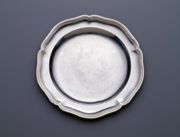Silver Plates by Lamine
Artist/Maker: Pierre-Jacques Lamine (active 1784-c. 1801)
Created: 1786-1787
Origin/Purchase: Paris
Materials: silver
Dimensions: D: 26 (10 1/4 in.); Total wt: 2322 g (74 oz. 13 dwt.)
Location: Tea Room
Owner: Thomas Jefferson Foundation
Accession Number: 1958-11-3/4; 1957-32; 1957-33
Historical Notes: On January 8, 1787, Jefferson wrote to Mathew Boulton, the best-known manufacturer of silverplated wares in England. He requested estimates on plated soup tureens as well as "10 dishes, round, of 10½ Inches diameter" and six oval platters.[1] He never purchased these items, but his letter attests to a need for serving pieces in silver or silverplate.
These four silver plates were acquired in Paris a short time later, probably in February 1787 when Jefferson paid a merchant named Cellier 657 livres for a quantity of silver.[2] The plates are a little more than ten inches in diameter, slightly larger than typical dinner plates yet similar to the ten round dishes mentioned in the inquiry to Boulton. Their style suggests a much earlier date than that indicated by their 1786-87 Paris guild marks. Plates and platters with a shape and reeded edge first appeared in France in the 1730s and remained popular for the rest of the century.
Serving dishes were commonly placed on the table in symmetrically arranged pairs, so they were usually purchased in pairs or even-numbered sets. Round dishes were particularly suitable for serving second-course fare such as cakes, pies, and puddings, but meat dishes and first-course entrées called for larger oval or oblong platters.[3] The packing list of Jefferson's goods shipped to America in 1790 mentioned the four silver platters ("quatre plats d'argents").[4] The silver plates were used at Monticello for many years. Martha Jefferson Randolph included "4 flat ditto [dishes]" on a list of family silver made about 1823. The "4 round dishes" were still in her possession in the 1830s, according to another silver inventory.[5] For Jefferson's family, the plates had a very strong personal association, and together with four silver vegetable dishes were considered among the most precious objects passed down in the Randolph family.
- Text from Stein, Worlds, 320
References
- ^ Jefferson to Mathew Boulton, January 8, 1787, in PTJ, 11:25-26. Transcription available at Founders Online.
- ^ Jefferson, February 17, 1787, in MB, 1:653. Transcription available at Founders Online.
- ^ Margarer Hollan, Phaidon Guide to Silver (Englewood Cliffs, NJ: Prentice-Hall, Inc., 1983), 120-22.
- ^ Grevin packing list, July 17, 1790, William Short Papers, Library of Congress. See also Short to Jefferson, November 7, 1790, in PTJ, 18:30-39n. The accompanying editorial note, available at Founders Online, includes extensive data on the 86 crates packed by Grevin.
- ^ Martha Jefferson Randolph, housewife list, c. 1823, and silver inventory, c. 1833, Thomas Jefferson Foundation, Inc.
